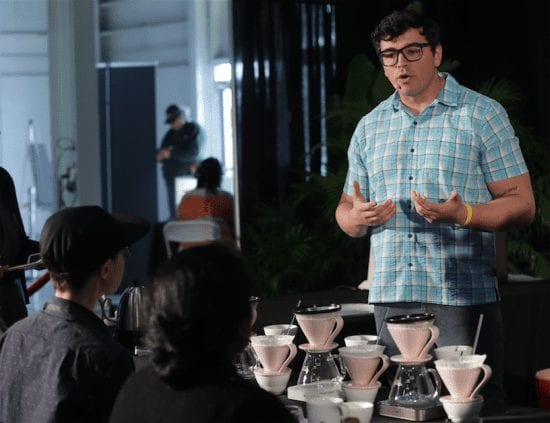
We talk to the Brewers Cup competitor about removing coffee fines, grossing out the judges, and much more.
BY CHRIS RYAN
BARISTA MAGAZINE ONLINE
Cover photo by The Pour courtesy of Pacific Foods
Every year in the U.S. CoffeeChamps’ Brewers Cup competition, participants introduce more innovative techniques in crafting their coffees for the judges. This year’s U.S. Brewers Cup Championship in Costa Mesa, Calif., was no exception: In the final round, Lance Hedrick of Onyx Coffee Lab—who would go on to finish second in the competition to his colleague Elika Liftee—introduced a particularly novel way of removing the fines (the super-tiny particles that appear in any grind) from his coffee. Midway through making coffee for the judges, he put the coffee grounds in a metal filter, then moved the filter and grounds into a new cone with a used paper filter, in turn taking the fines out of the equation.
In addition to helping Lance earn second place in the competition, the fines technique earned the attention of the specialty-coffee community—this post from coffee consultant and writer Scott Rao was just one example. We talked to Lance to learn the details of developing and executing this trick.

Chris Ryan: First, why did you want to remove the fines from your coffee? How did you feel they affected your brew, and why did you think it would be better without them?
Lance Hedrick: When I began learning the basics of brewing, I was taught, as many are, that there exists a scale from body to clarity. For instance, a French press will give you a massive body, but no clarity, while a V60 would give you extreme clarity, but little body. Since then, I’ve been motivated to try and present a cup that showcases both. Well, recently there has been a move to remove fines completely from the grounds; however, the resulting cups typically exhibit weak bodies. It’s common knowledge that fines over-extract easily, contributing to bitterness, but it’s typically overlooked that their continued presence in the bed also slows down the drain and can cause choking, leading to the over-extraction of larger particles. I wanted to remove the fines to both cease their extraction after they contributed to the final cup positively and to speed up the end of the brew, lessening contact time near the end of the brew when I’m hitting my target ratio. Overall, this (theoretically) allowed me to use the fines for the body they help produce and remove them before they muddled the clarity achieved in the brew process.
How did you develop the method you used, by moving the metal filter mid-extraction into a new cone and filter? What other methods did you play around with before settling there, if any? And why did the method you settle on work best?
Ray Murakawa, friend and inventor of the MeloDrip, posts videos of experimental brews almost daily. Around eight or so months ago, I saw him post a brew where he used both a mesh filter AND a paper filter, demonstrating the increasing flow rate from the separation of the filters. Following the brew, he showcased the paper filter, which was littered with fines. The realization of what I could do was almost instantaneous—I then just had to play around with the movements, agitation, ratio, temperature, grind size, etc., until it worked.
Before seeing this from Ray, I tried sifting out the fines, placing an AeroPress filter on top of the bed in a V60, placing the fines on top of that filter at the end of the brew, and brewing through the AeroPress filter (lessening the direct agitation on the spent grounds in the bed) but focusing on those exposed fines for a concentrated extraction. I knew I wanted a partial extraction of fines, so it was all about figuring out how to achieve that.

As I continued playing with ideas, I figured that sifting out the fines and reintroducing them wasn’t consistent. The fines tend to bunch up and, even with great agitation, don’t always want to separate. So, each time, even if I had the same amount of grams of fines, they would extract differently.
Thankfully, I saw Ray’s video and was able to (relatively quickly) figure out an alternative with no sifting.
Was it a hard thing to execute mid-routine? Did you feel like it added a degree of difficulty?
I almost decided against using this brew method. The changes mid-brew caused a lot of issues with timing, mostly. I ended up relying on my routine last year (a study on the thermodynamic retention of the bed of grounds) to allow me to extend the time between pours two and three. This allowed me sufficient time to switch out the brewers and move the mesh filters without making a mess. All that was left, after deciding on extending the time between pours, was the temperature the water should be to make up for the dip that inevitably happens once the bed dries out (though minute).

You showed the judges the two filters and their fines—can you please explain what that showed and why it was an effective thing to show the judges?
Pseudoscience is pretty rampant in brew theory today. Even in my own routine, I’m relying on theories that have not been objectively proven. Because of this, I wanted to be able to show, objectively, at least a portion of my presentation was truly happening. I argue that my method is able to successfully discharge the MAJORITY of the fines midway through the brew. Now, to the ear, this sounds nice, but not many realize just how many fines are produced, even on a grinder like the EK43. I wanted to give a visual to the judges to get my point across about what would happen if we left all those fines in. During my numerous practices, I would sift my doses to weigh the amount of fines the grinder produced (roughly 2.5g average). I’d then do the brew, allow the filters to dry out, and weigh the difference of the dry filter versus the filter with the dried fines left (ranging from 1.7-2g). The final filter revealed less than .4g on average. By showing the filters, I was able to accomplish a few things:
1) Prove my statement I could remove the majority of the fines.
2) Demonstrate just how much of the bed is truly made of these minuscule grounds that extract (and therefore over-extract) extremely quickly.
3) Gross out the judges with the sludge-like characteristics of the wetted fines by scraping them back with my stir stick, giving a little extra oomph to the presentation of the filters.
Finally, what kind of feedback did you get from judges/the coffee community/etc. about using the fines removal tactic in your routine?
The feedback has been incredible. I’ve had people from at least eight or so different countries and around the U.S. send me photos of them trying this method. Out of all the attempts and comments, the most critical response I saw was by someone who hadn’t tried it, but said they were “skeptical.” Haha! So, feedback has been incredible.
Of course, some have seen Scott Rao’s post on my routine, which I was certainly humbled by. Additionally, the judges were impressed with the creativity of the routine as a whole. It also helps that the body scores on my scoresheets were extremely high, with one of the judges giving me 28 out of the 31 flavor notes I called, revealing an extremely high flavor clarity.
The main issue with the brew is repeatability. My sensory uniformity wasn’t too high because the cup changed pretty aggressively from cup to cup, making my score suffer. Overall, I couldn’t have asked for a better response. I’m hoping to get the brew on a video to release for those wanting a more in-depth overview of the brew itself. Until then, I’ll be as responsive as I can to the DMs coming my way regarding the process.

